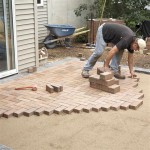```html
Cost For Paving Patio: A Comprehensive Guide
The installation of a paved patio can significantly enhance the aesthetic appeal and functionality of any outdoor living space. Understanding the cost implications associated with paving a patio is crucial for effective budgeting and planning. Numerous factors contribute to the overall expense, requiring careful consideration before embarking on such a project. This article provides a comprehensive overview of the cost elements involved in paving a patio, enabling homeowners to make informed decisions.
The final cost for paving a patio is rarely a fixed number. It is influenced by variables such as the size of the patio area, the type of paving material chosen, the complexity of the design, site preparation requirements, and labor costs. Furthermore, geographical location can play a significant role, with material and labor prices fluctuating across different regions. Therefore, obtaining multiple quotes from reputable paving contractors is highly recommended to gain a realistic understanding of the potential cost.
Key Point 1: Material Costs and Considerations
The selection of paving materials is arguably the most significant factor influencing the overall cost of a patio project. Various options are available, each with its unique price point, aesthetic qualities, and durability characteristics. Common choices include concrete pavers, brick pavers, natural stone (such as flagstone, slate, and limestone), and porcelain pavers.
Concrete pavers are generally the most economical option, offering a wide range of colors, shapes, and textures. They are durable, relatively easy to install, and require minimal maintenance. The cost of concrete pavers typically ranges from $3 to $10 per square foot, depending on the style and manufacturer.
Brick pavers offer a classic and timeless aesthetic, adding character and charm to any outdoor space. They are durable and long-lasting but tend to be more expensive than concrete pavers. The cost of brick pavers can range from $5 to $15 per square foot, depending on the type of brick and the complexity of the installation pattern.
Natural stone pavers, such as flagstone, slate, and limestone, provide a luxurious and natural look. They are highly durable and resistant to weathering but are also the most expensive paving option. The cost of natural stone pavers can range from $10 to $30 per square foot, depending on the type of stone, its thickness, and the availability in the local market.
Porcelain pavers are a relatively new option, gaining popularity due to their durability, stain resistance, and wide range of design possibilities. They are also frost-resistant, making them suitable for colder climates. The cost of porcelain pavers typically ranges from $8 to $20 per square foot.
Beyond the cost per square foot, potential homeowners also should factor in the amount required for waste and cuts. It is typical for contractors to order 5-10% extra in materials to account for breakage, miscalculations, and pattern matching during the laying process.
Key Point 2: Labor Costs and Installation Factors
Labor costs represent a significant portion of the overall expense of paving a patio. These costs will vary depending on the contractor's experience, the complexity of the project, and the geographical location. Labor costs generally include site preparation, base preparation, paver installation, and joint sanding or sealing.
Site preparation involves clearing the area of any existing vegetation, debris, and topsoil. This may also include grading and leveling the ground to ensure proper drainage. Base preparation involves installing a compacted base of gravel or crushed stone, which provides a stable foundation for the pavers. The depth of the base depends on the type of soil and the expected traffic load.
Paver installation involves laying the pavers in the desired pattern, ensuring proper spacing and alignment. This requires skill and precision to achieve a visually appealing and structurally sound patio. After the pavers are laid, the joints between them are filled with sand or a polymeric sand to stabilize the pavers and prevent weed growth.
Sealing the pavers is an optional step that can protect them from staining, fading, and weathering. Paver sealers are available in various finishes, such as matte, satin, and gloss. The cost of sealing pavers typically ranges from $1 to $3 per square foot.
The complexity of the installation pattern can also affect labor costs. Simple patterns, such as a running bond or herringbone, are generally less expensive to install than more intricate patterns, such as a basketweave or circular design. Curves and angles in the patio design also increase the difficulty and time required for installation, thereby increasing labor costs. Access to the area is another aspect. If machinery cannot reach the site, material has to be moved by hand, which adds to labor costs.
On average, labor costs for paving a patio range from $5 to $15 per square foot. This cost can vary depending on the factors mentioned above. Complex projects may require specialized equipment or techniques, which can further increase labor costs.
Key Point 3: Additional Costs and Considerations
In addition to material and labor costs, several other expenses should be factored into the overall budget for paving a patio. These may include permits, excavation, demolition, drainage improvements, and landscaping.
Permits may be required by local building codes, especially for larger patio projects or those that involve structural changes. The cost of permits varies depending on the municipality and the scope of the project. It is essential to check with the local building department to determine if a permit is required and what the associated fees are.
Excavation may be necessary to remove existing structures, such as old patios, walkways, or landscaping features. The complexity of the excavation work will depend on the size and depth of the removal. Demolition can be costly and increase the amount of materials that need to be removed. In some cases, a demolition permit is required and costs should be accounted for.
Drainage improvements may be necessary to ensure that rainwater is properly diverted away from the patio area. Poor drainage can lead to water damage, erosion, and other problems. Drainage solutions may include installing French drains, catch basins, or grading the ground to create a slope away from the house.
Landscaping can enhance the aesthetic appeal of a paved patio and create a more inviting outdoor living space. Landscaping options may include planting trees, shrubs, flowers, and installing edging or retaining walls. The cost of landscaping will depend on the scope of the work and the materials used.
Consider the cost of tools and equipment. While a paving contractor will supply specialized tools, there may be costs for renting a compactor or other heavy machinery if a homeowner is doing the project themselves. Furthermore, safety gear, such as gloves, eye protection, and knee pads, will add to the overall expense.
Finally, remember the cost of disposal for excavated materials as well as packaging of materials. These materials need to be disposed of responsibly, and often a local disposal company will need to be contracted for removal. This should be accounted for as part of the overall cost.
```
How Much Does A Patio Cost Installation 2024 Landscaping Network

Stone Patio Paving Costs How Much Does A Cost

Cost To Install A Patio 2024 Calculator

Paver Cost Landscaping Network

Guide How Much Does A Paver Patio Cost In 2024

How Much Do Flagstone Patios Cost In 2024 Forbes Home

How Much Does It Cost To Install Patio Pavers In 2024 Paver House

How Much Does A New Patio Cost In 2024 Checkatrade
How Much Does A Paver Patio Cost Quora

How Much Does It Cost To Build A Patio In 2024 Forbes Home
Related Posts








